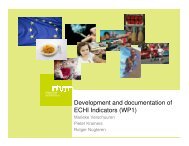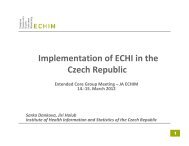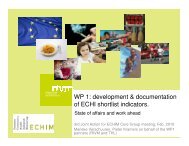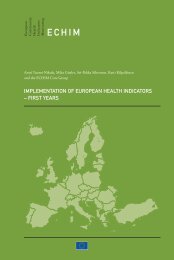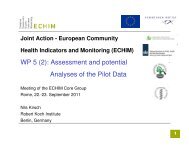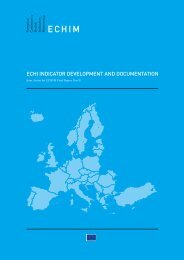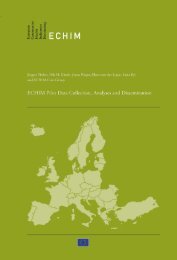INDICATORS
ECHIM Final Report
ECHIM Final Report
Create successful ePaper yourself
Turn your PDF publications into a flip-book with our unique Google optimized e-Paper software.
The last questions were about the respondents’ initial ideas of implementing the ECHI<br />
system in their countries, and their suggestions or comments on the ECHI indicator<br />
list. These questions served as an introduction to the Bilateral Discussions, in which the<br />
same topics were considered more deeply. These issues are the focus of Chapter 5.4.<br />
5.3. Comparing Country Reports and ECHIM Survey results<br />
As far as indicator data were concerned, the purpose of the ECHIM Survey was to<br />
deepen the information provided by the Country Reports. The Country Reports simply<br />
reviewed the availability of national indicator data in international data sources. The<br />
ECHIM Survey examined the original national data sources. An important added value<br />
of the survey was that it revealed origins and clarified data quality for many indicators,<br />
for which metadata in the international data sources were sometimes quite vague. It<br />
was equally important to discover that much data are available nationally that are not<br />
available in international data sources.<br />
In connection with replying to the ECHIM Survey, the contact persons were also asked<br />
to check the information of their Country Reports. In most cases the figures were correct,<br />
but some inaccuracies were also reported. These were isolated cases, though, and may be<br />
explained by typing errors when entering data in the databases. Also the use of different<br />
data calculation methods and different standard populations in age-standardisation may<br />
have had an impact on the figures.<br />
When it comes to data quality, there were much more alarming cases where the<br />
information gained by the ECHIM Survey made the information in the Country<br />
Reports seem very questionable. According to the Country Report, one country was<br />
ranked high by data availability (data available for 79% of ECHI shortlist indicators).<br />
However, the ECHIM Survey and the related Bilateral Discussion revealed that there<br />
are in fact very little register data available in that country. Majority of the data are based<br />
on very rough estimates based on small, often unreliable samples.<br />
Many of the contact persons pointed out that the necessary data would be available even<br />
though they were missing from the international databases. These cases were mainly<br />
breaks in time series, though. A more important issue is that for many ECHI shortlist<br />
indicators, there are no datasets in the databases of Eurostat, WHO or OECD. This<br />
cannot always be explained by data availability, since for some of these indicators the<br />
data would be available at country level in almost all the surveyed countries. Clear<br />
examples include asthma, high blood pressure and social support. A feature shared in<br />
common by all these indicators is that there is a wide variety of optional acceptable<br />
definitions, a fact that may have halted their implementation in the databases.<br />
63



